Vatha kuzhambu recipe with step by step pics. One of the simplest recipe I make at times is vatha kulambu. This vathal kuzhambu recipe and method gives you a really tasty and tongue-tickling kuzhambu. The recipe is vegan and quite nutritious as well.
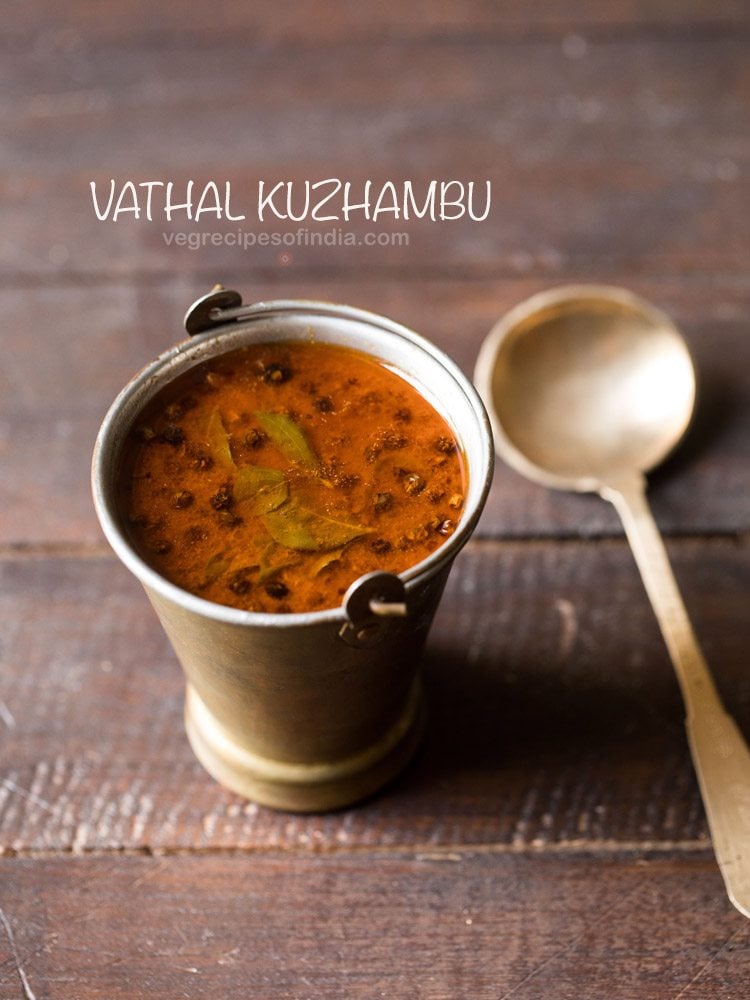
Vathals is the Tamil word for sun dried vegetables or berries. The veggies or berries are soaked in buttermilk for some hours or overnight and later sun dried. In this recipe post I have shared the method of making manathakkali kuzhambu. Manathakkali is the Tamil word for black nightshade berries. These are also called as makoy in Hindi language.
The unripe green berries are soaked in buttermilk and then sun dried. Later these sun dried berries can be fried with very little oil and served with Curd Rice or rasam-rice. A simple kuzhambu can also be made with these sun dried berries.
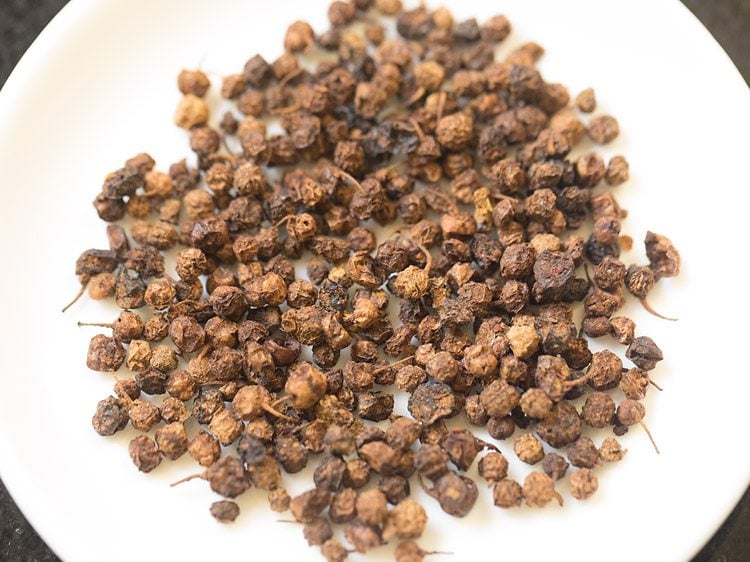
Manathakkali vathal kulambu recipe does have health benefits. The berries help in digestion as well as even help in getting rid of stomach infections. This kuzhambu also improves the appetite.
The taste of manathakkali kuzhambu is complex. You get to have sour, bitter, spiced, salty and astringent taste in the curry. So its best served with some steamed rice where the flavors do get mellowed a bit. Savoring vathal kulambu is an acquired taste and you may or may not like it in the first go.
When having manathakkali kulambu with steamed rice, you do get a bite of the softened berries with a hints of saltiness, sourness and slight bitterness in them.
Apart from manathakkali kuzhambu recipe, I also use the same recipe and make it with sun dried turkey berries (sundakkai). At times I also add pearl onions (sambar onions) and garlic. But in this post, I am sharing a no onion no garlic recipe which is a tamil brahmin version.
A few other kuzhambu variations I have already posted on blog are:
A few points have to be remembered when making a perfect vatha kuzhambu.
- If possible use dark tamarind or old tamarind as it gives a lovely deep sour taste.
- Be generous with oil. There should be a thin layer of oil on top of the kuzhambu. This helps in keeping the kuzhambu stay good for about a week in the fridge and also gives a good taste.
- For the best and authentic taste, use sesame oil (gingelly oil) which is cold pressed oil made from raw sesame seeds.
- After adding sambar powder, it should be fried in oil so that it releases its flavors.
- For a slight thickening of the kuzhambu gravy, you can add some rice flour.
- A bit of jaggery can also be added to balance the sourness and bitterness.
Vatha kuzhambu is best served with steamed rice. Accompany a side vegetable dish to make a wholesome meal. You can serve a poriyal or stir fry like vazhakkai poriyal or potato fry or french beans poriyal or suran fry with it.
With this vatha kuzhambu, I would suggest to serve a side vegetable dish which has faint sweet notes and not at all spicy or bitter.
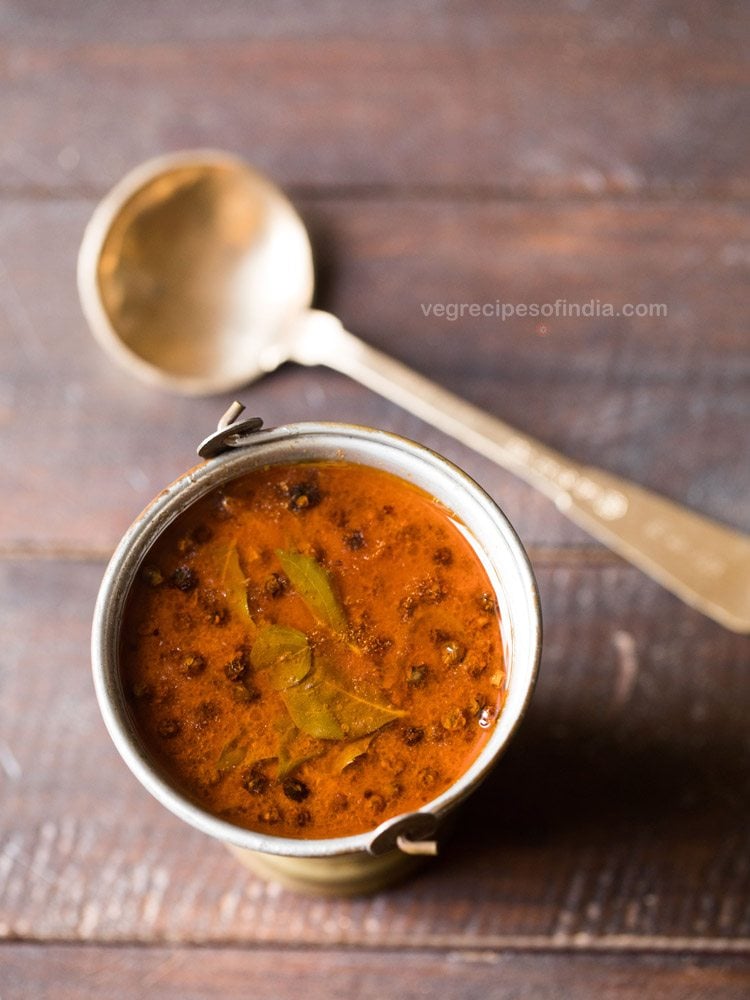
How to make Vatha Kulambu or vatha kuzhambu
A) soaking tamarind:
1. In a bowl take 1 lemon sized tamarind ball or 1 tablespoon tightly packed tamarind. Preferably use aged and dark tamarind. As it gives a lovely deep sourness to the kuzhambu.
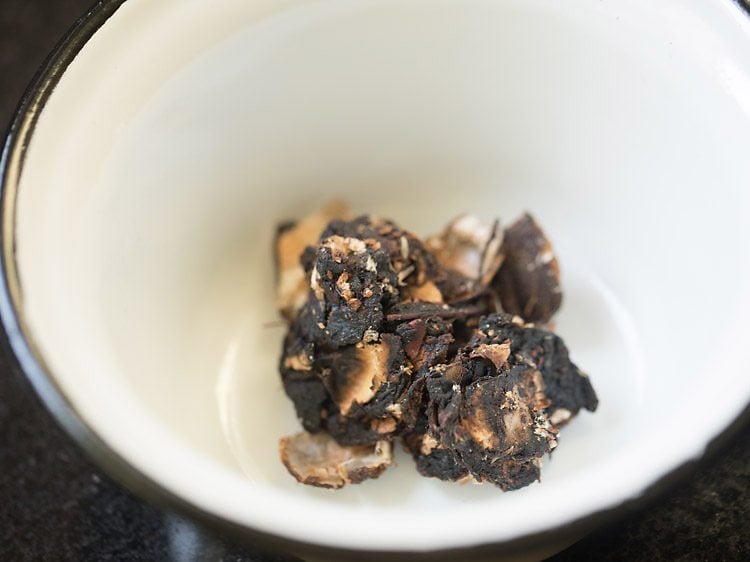
2. Add 1 cup hot water. Cover and soak tamarind for 20 to 30 minutes.
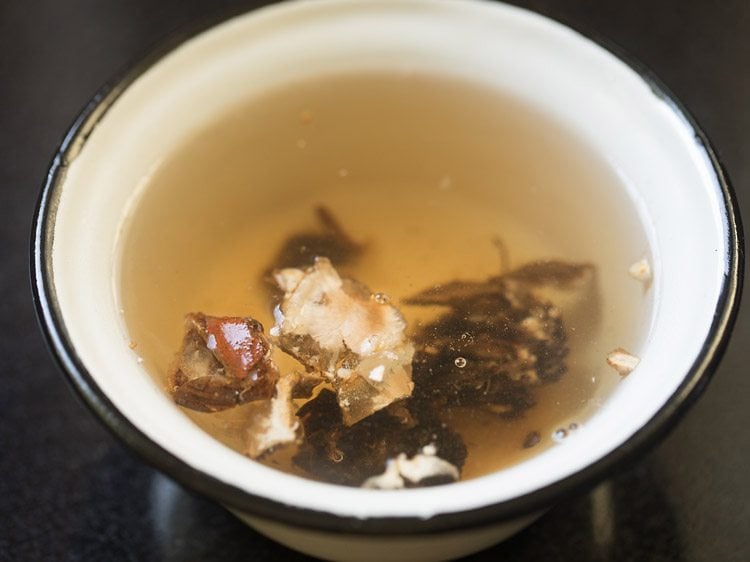
3. Squeeze the tamarind and extract the tamarind pulp in the water. Keep aside.
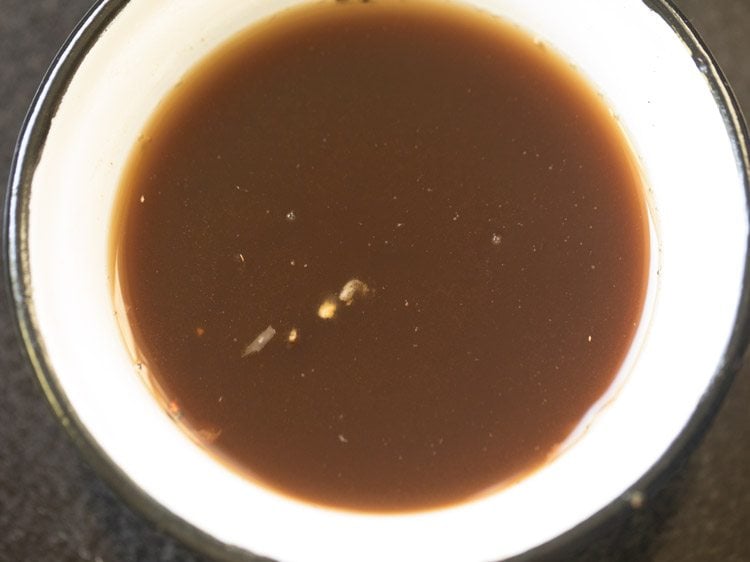
Making vatha kulambu
4. Heat 3 tablespoons sesame oil (gingelly oil) in a pan. Keep the heat to a low and add ½ teaspoon mustard seeds.
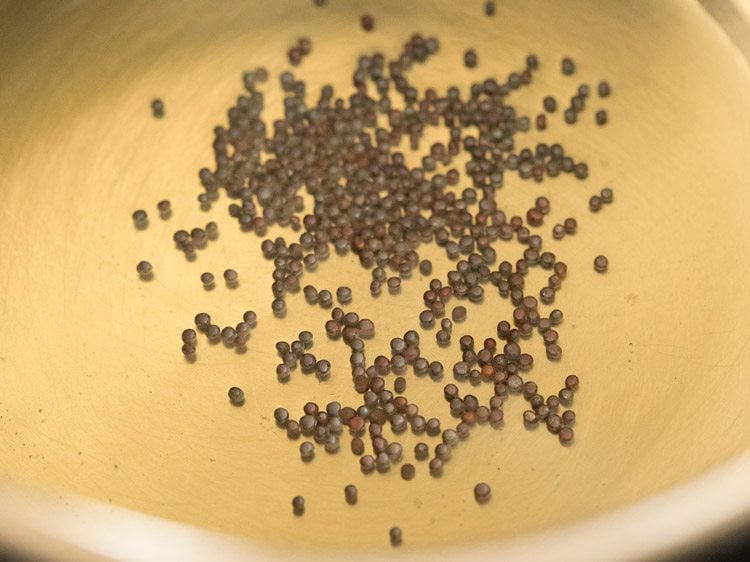
5. Let the mustard seeds crackle.
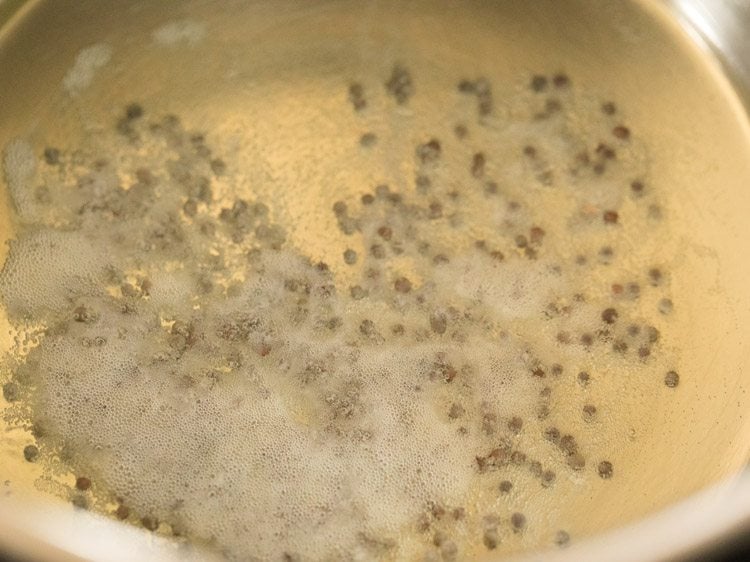
6. Keep the heat to a low and then add the following ingredients:
- ½ teaspoon fenugreek seeds
- 1 to 2 dry red chilies (halved and seeds removed)
- 8 to 10 curry leaves
- 1 pinch asafoetida (hing)
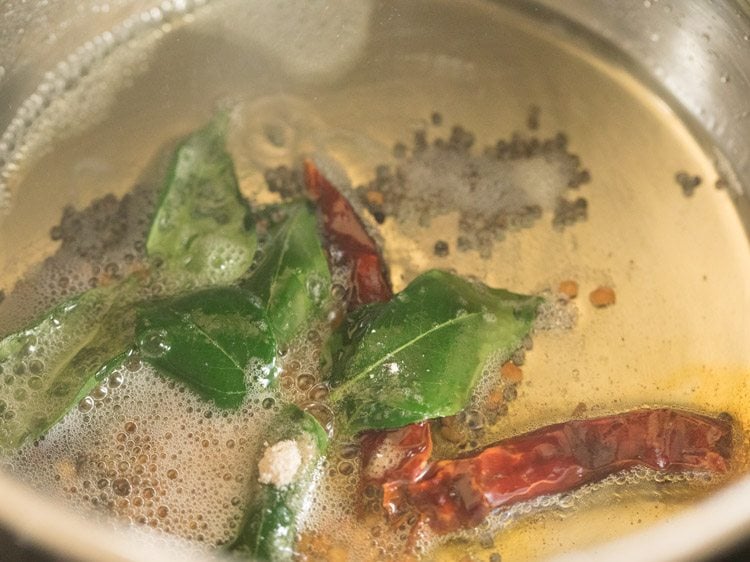
7. Fry and stir till the red chilies change color.
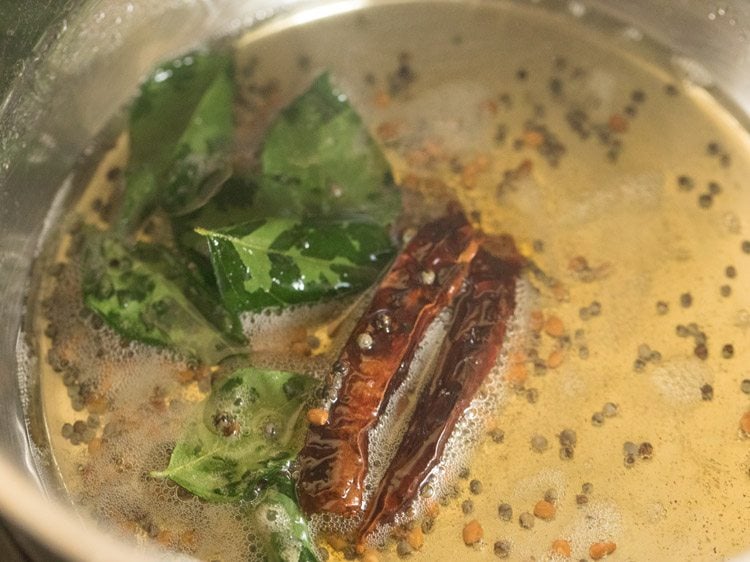
8. Keeping the heat to a low, now add 3 tablespoons manathakkali vathal (sun dried black nightshade).
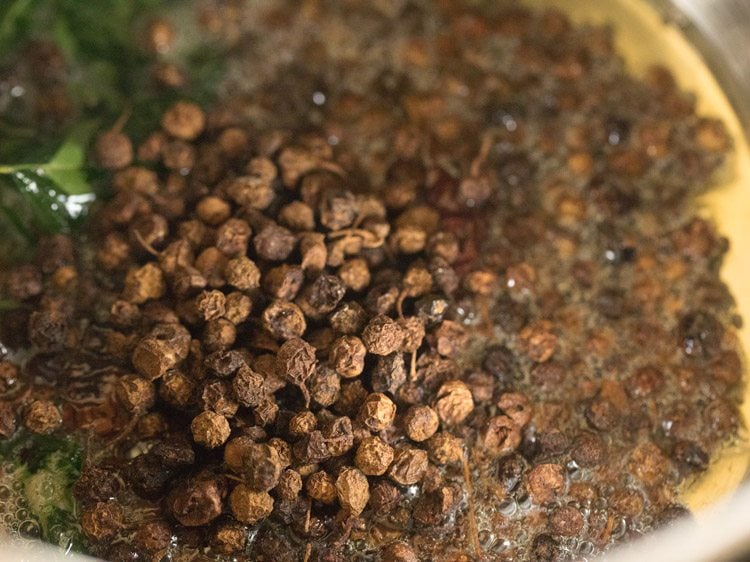
9. Stirring continuously, fry for some seconds till the color of manathakkali changes. Make sure you do not burn them.
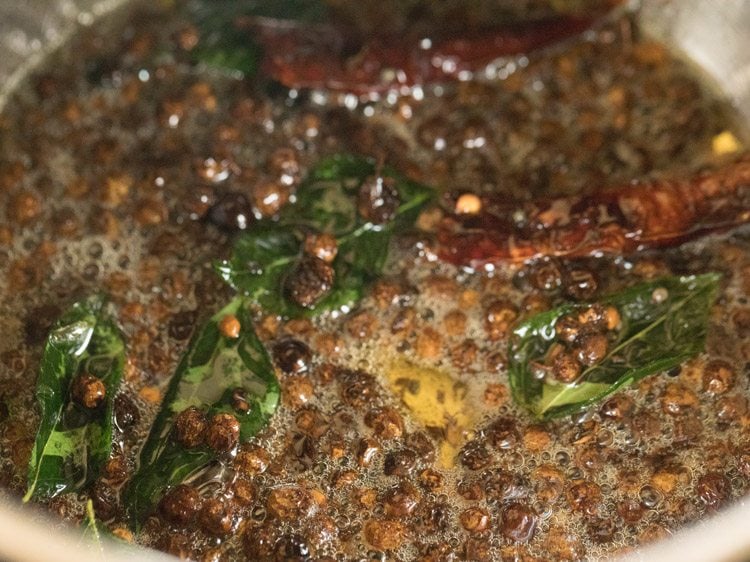
10. Now switch off the heat and add 1.5 to 2 tablespoons of sambar powder.
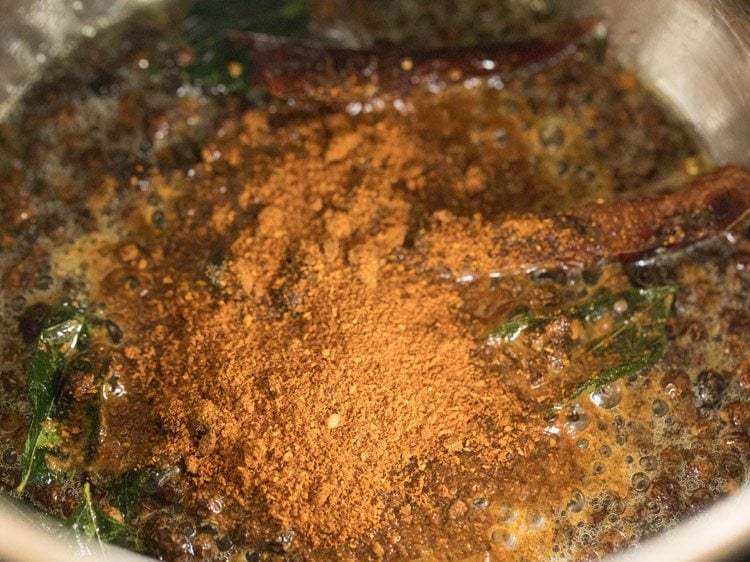
11. Fry for 1 minute switching off the heat. You can even fry at a low heat. But do make sure that the sambar powder does not get burnt.
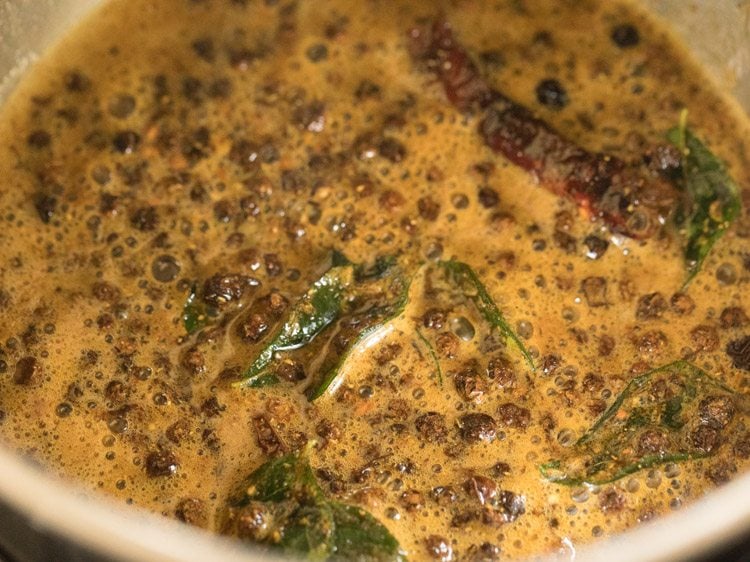
12. Add the tamarind pulp.
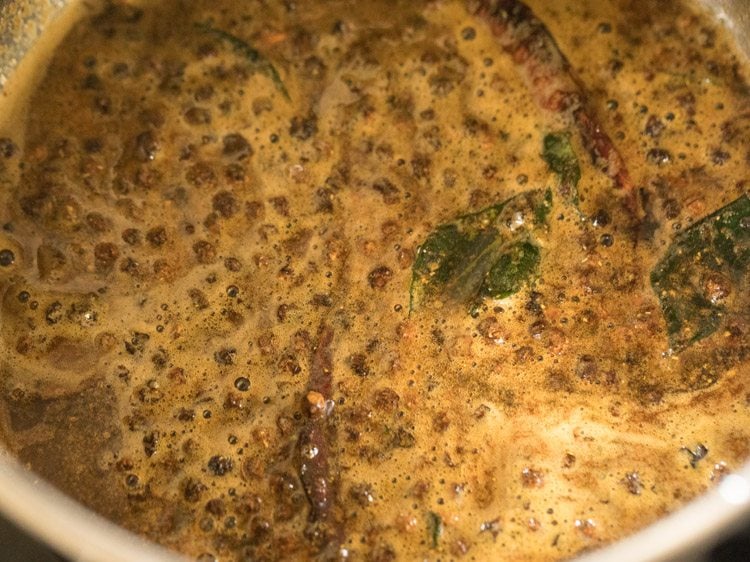
13. Pour 2 cups water.
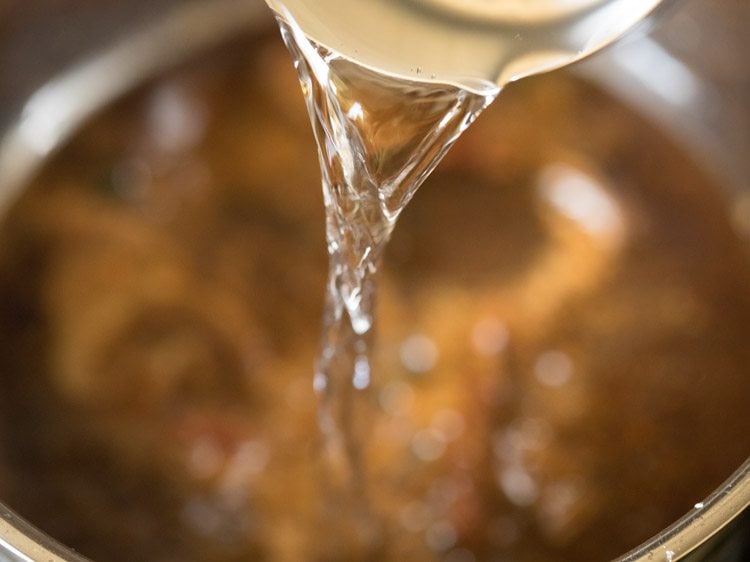
14. Give a stir.
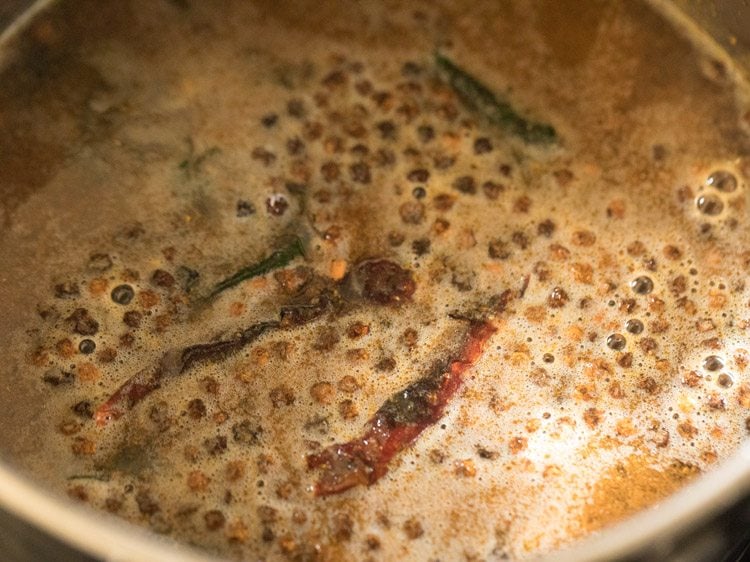
15. Add salt as per taste.
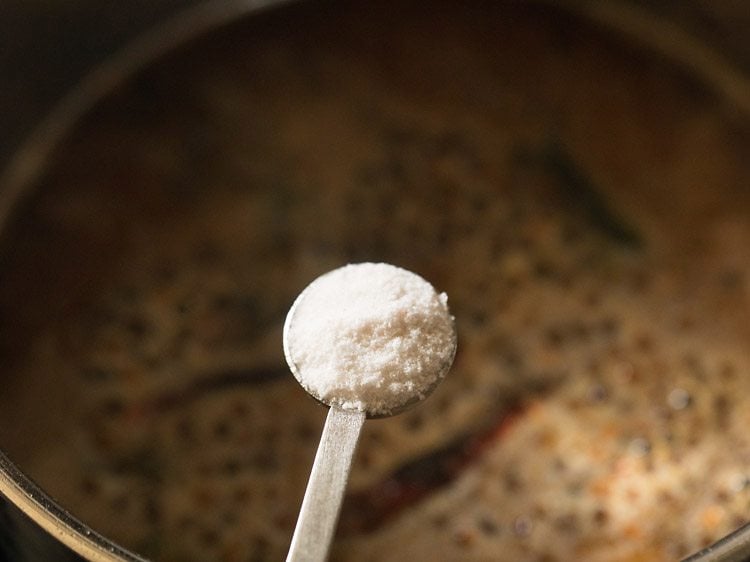
16. Mix well and let this vatha kuzhambu come to a boil on medium-low heat for about 25 to 30 minutes.
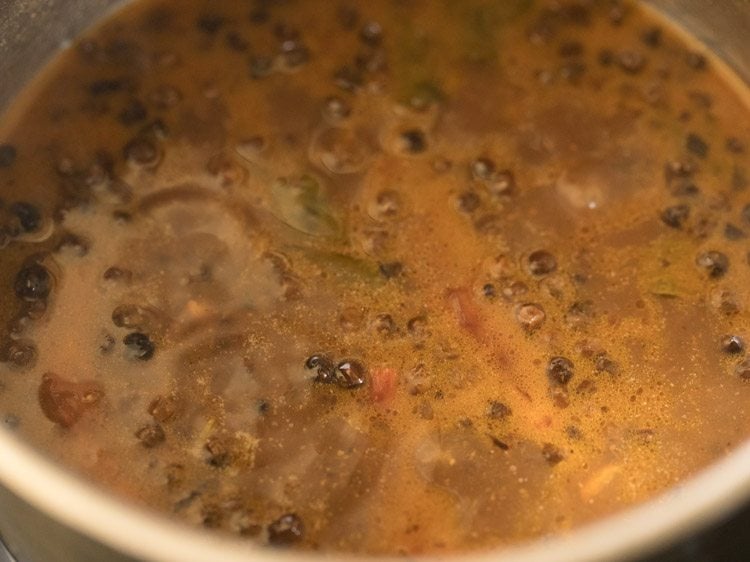
17. Continue to simmer till the curry or gravy thickens slightly. You will see some oil specks on the top.
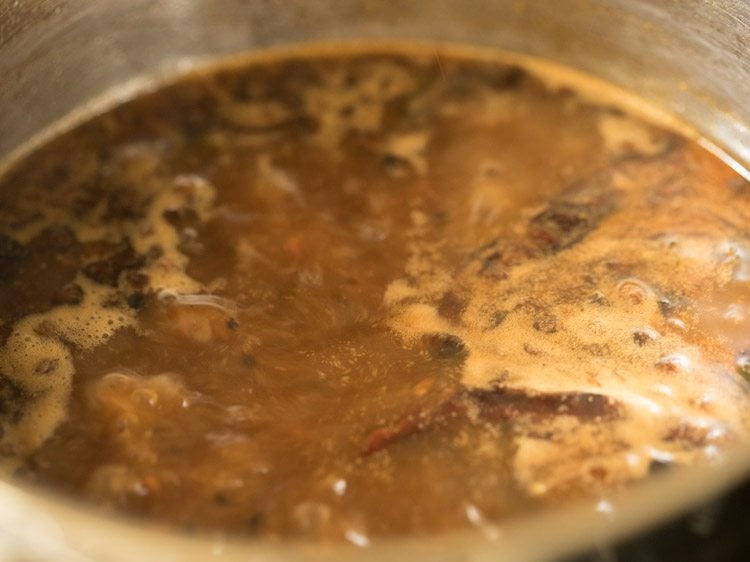
18. Then add 1 teaspoon rice flour. Adding rice flour is optional and can be skipped.
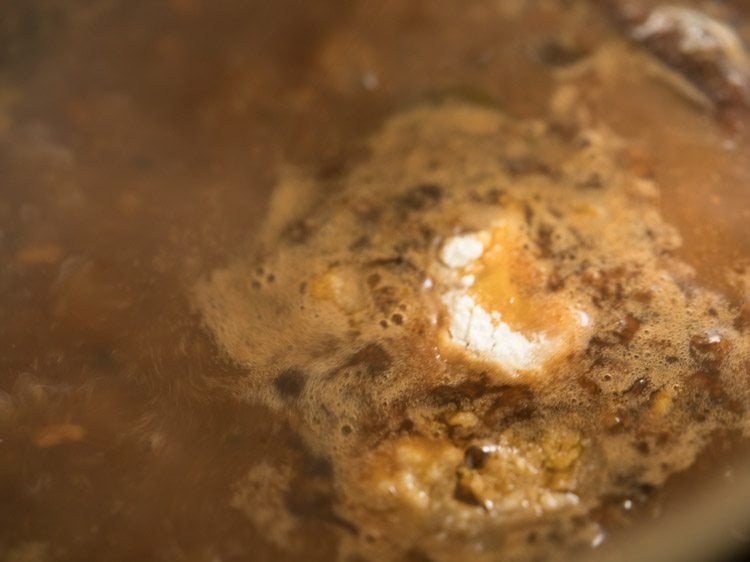
19. Add ½ teaspoon jaggery. Adding jaggery is also optional.
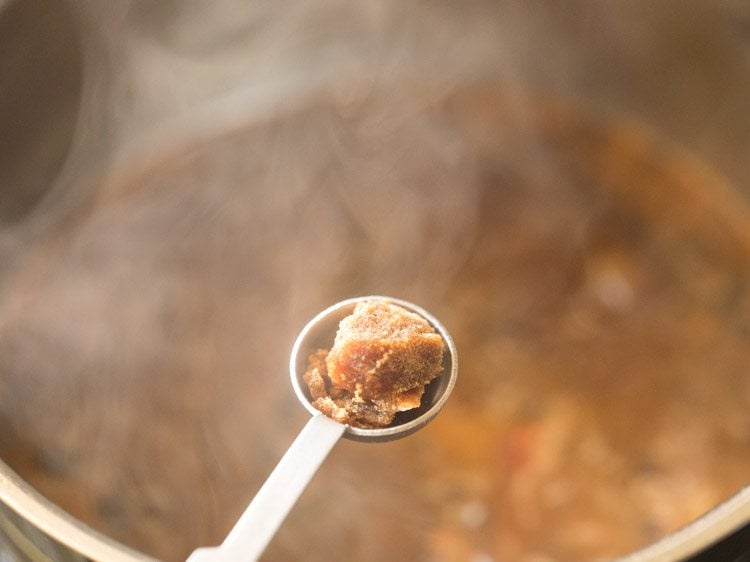
20. Mix well and continue to simmer vatha kuzhambu for 4 to 5 minutes more. After you switch off the heat. You should clearly see a layer of oil after allowing the kuzhambu to rest for 1 to 2 minutes. Check the taste and add more salt if required.
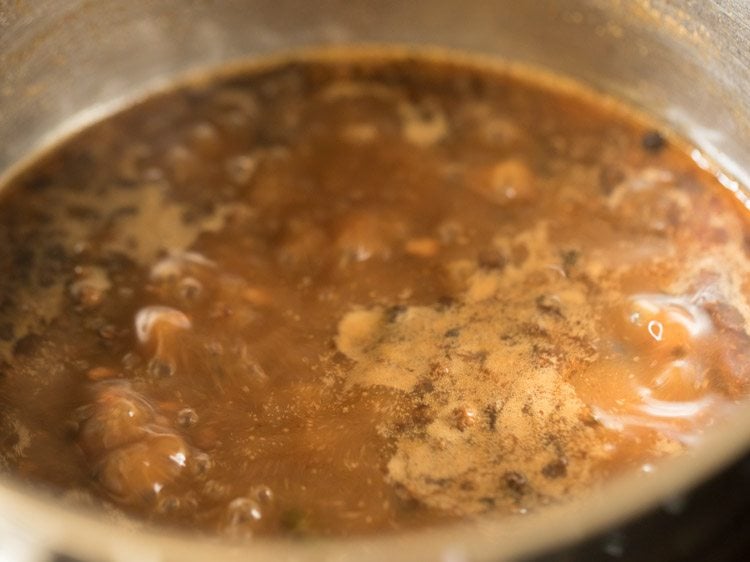
21. Serve vatha kulambu hot with steamed rice. You can also accompany a side vegetable dish like a poriyal or stir fry like vazhakkai fry or baby potato fry or vendakkai poriyal or carrot poriyal.
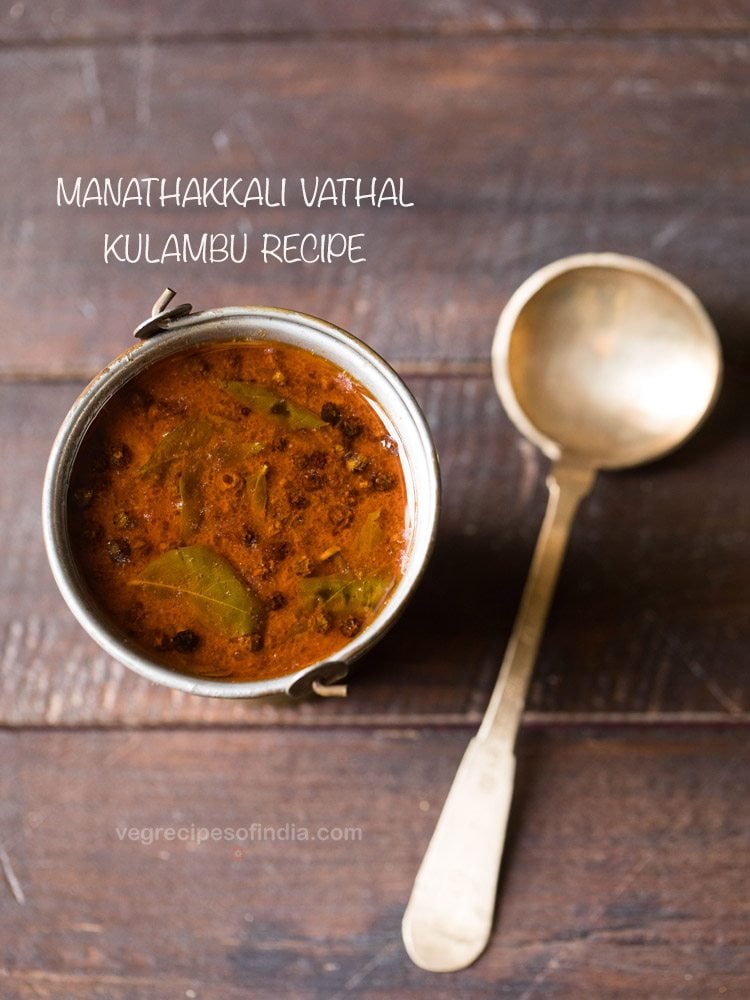
Please be sure to rate the recipe in the recipe card or leave a comment below if you have made it. For more vegetarian inspirations, Sign Up for my emails or follow me on Instagram, Youtube, Facebook, Pinterest or Twitter.
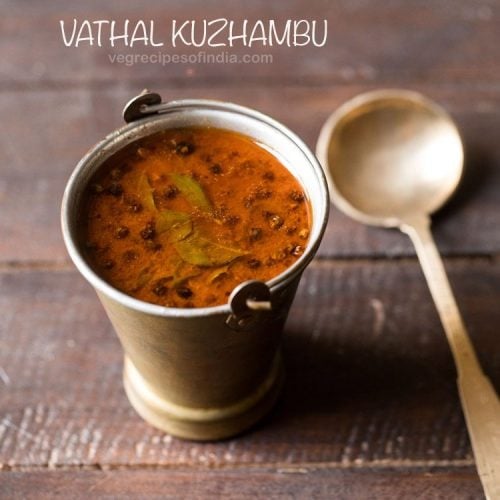
Vatha Kulambu | Vatha Kuzhambu
Ingredients
for soaking tamarind
- 1 lemon sized tamarind ball or 1 tablespoon tightly packed tamarind
- 1 cup hot water
for making vatha kulambu
- 3 tablespoons sesame oil (gingelly oil)
- 3 tablespoons sundried black nightshade berries (manathakkali vathal)
- ½ teaspoon mustard seeds
- ½ teaspoon fenugreek seeds
- 1 to 2 dry red chilies, broken and seeds removed
- 8 to 10 curry leaves
- 1 pinch asafoetida (hing)
- 1.5 to 2 tablespoons Sambar Powder
- 2 cups water
- salt as required
- 1 teaspoon Rice Flour – optional
- ½ teaspoon jaggery – optional
Instructions
soaking tamarind
- In a bowl take 1 lemon sized tamarind ball or 1 tablespoon tightly packed tamarind. Preferably use aged and dark tamarind.
- Add 1 cup hot water. Cover and soak tamarind for 20 to 30 minutes.
- Squeeze the tamarind and extract the tamarind pulp in the water. Keep tamarind pulp aside.
making vatha kuzhambu
- Heat 3 tablespoons sesame oil (gingelly oil) in a pan. Keep flame to a low and add ½ teaspoon mustard seeds.
- Let the mustard seeds crackle.
- Keep the flame to a low and then add ½ teaspoon fenugreek seeds, 1 to 2 dry red chilies, 8 to 10 curry leaves and 1 pinch asafoetida (hing).
- Fry and stir till the red chilies change color.
- Keeping the flame to a low, now add 3 tablespoons manathakkali vathal (sun dried black nightshade).
- Stirring continuously, fry for some seconds till the color of manathakkali changes. Make sure you do not burn them.
- Now switch off the flame and add 1.5 to 2 tablespoons sambar powder.
- Fry for 1 minute switching off the flame. You can even fry at a low flame. But do make sure that the sambar powder does not get burnt.
- Add the tamarind pulp and 2 cups water. give a stir.
- Add salt as per taste. mix well and let this vatha kuzhambu come to a boil on medium-low flame for about 25 to 30 minutes.
- Continue to simmer till the curry or gravy thickens slightly. You will see some oil specks on the top.
- Then add 1 teaspoon rice flour. Adding rice flour is optional and can be skipped.
- Add ½ teaspoon jaggery. Adding jaggery is also optional.
- Mix well and continue to simmer vatha kulambu for 4 to 5 minutes more. After you switch off the flame you should clearly see a layer of oil after allowing the kuzhambu to rest for 1 to 2 minutes. Check the taste and add more salt if required.
- Serve vatha kuzhambu with steamed rice.
Nutrition Info (Approximate Values)
This Vatha Kulambu post from the archives, originally published in February 2018 has been updated and republished on February 2023.








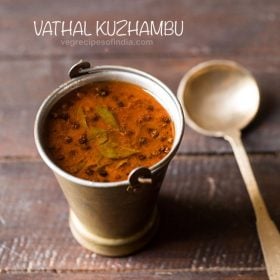
I tried this recipe exactly today, turned out super awesome. Thank you for putting together such recipes in a very simple format.
Wonderful and thanks for letting me know. Thanks also for the feedback on the rating.
Hi,
Can we use the sambar powder which is available in market.
yes you can use the sambar powder available in the market.
Loved the recipe. Easy to make. Your recipes always work for me.
thanks rithika. glad to know. happy cooking.
Are these the berries of the ‘Solanum Nigrum’ that grows in Europe too? I’ve always been told they are poisonous but as they pop up unasked and abundatly in our vegetable garden, it would be nice te be able to eat them.
these are the berries of solanum nigrum. there is another plant in europe which is a poisonous one and is called as deadly nightshade. the ones found in india is safe to consume. in southern parts of india, black night shade plants grow in the courtyards and gardens. so the leaves are also used in cooking. ripe berries are also consumed. leaves should be always be cooked before eating and berries must be ripe before having them.
you can check this linked in link which is helpful – https://www.linkedin.com/pulse/from-nutritionists-diary-the-wonder-greens-chandra/
and the below link tells about the difference between deadly nightshade and black nightshade – https://www.rootsimple.com/2011/11/deadly-nightshade-vs-black-nightshade/